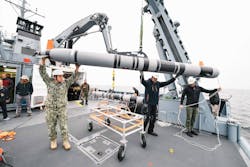Hydroid to upgrade sensors for mine-countermeasures on Navy MK 18 Mod 2 unmanned underwater vehicle (UUV)
NEWPORT, R.I. – U.S. Navy mine-countermeasures experts are asking Hydroid Inc. in Pocasset, Mass., to design enhanced undersea sensors to enhance the ability of the MK 18 Mod 2 Kingfish unmanned underwater vehicle (UUV) to detect and pinpoint buried undersea mines.
Officials of the Naval Undersea Warfare Center Division in Newport, R.I., announced a $74.7 million contract to Hydroid on Tuesday for MK 18 Mod 2 UUV Increment II Payload Upgrade hardware in support of the existing MK 18 Mod 2 UUV program.
The MK 18 Mod 2 Kingfish is a medium-to-heavyweight UUV designed to detect, locate, and map floating, moored, or buried sea mines in relatively shallow waters. It is a larger version of the MK-18 Mod 1 Swordfish, which is based on the Hydroid Remote Environmental Monitoring System (REMUS) 100 unmanned submersible.
Navy experts asked Hydroid to increase the size of the MK 18 MOD 2 Kingfish to enhance the UUV's power and onboard sensor capacity. Hydroid engineers increase the UUV's size simply by scaling-up the MK-18 Mod 1 design.
Navy experts are asking Hydroid to upgrade the MK 18 Mod 2 sensor and sensor-processing suite to enhance its ability to find and pinpoint mines in murky water or in other kinds of difficult environmental conditions like mud and sand.
The current MK-18 Mod 2 design has a dynamic-focus side-look sonar; conductivity and temperature sensor; beam attenuation meter optical sensor; pencil beam sonar for obstacle avoidance; and fluorometer and turbidity measurement sensors.
The MK 18 Mod 2 UUV is deployable from an 11 meter rigid-hull inflatable boat (RHIB). It is 12.75 inches in diameter, 11.5 feet long, and weighs about 600 pounds.
In addition to its mine-hunting sensors and onboard sensor processing, the MK 18 Mod 2 UUV has acoustic communications, Iridium satellite communications (SATCOM), and radio modem.
The UUV navigation system consists of an up- and down-looking acoustic Doppler current profiler; Doppler velocity log; inertial navigation unit; compass; and P-code Global Positioning System (GPS).
On this contract Hydroid will do the work in Pocasset, Mass., and should be finished by April 2026. For more information contact Hydroid online at www.hydroid.com, or the Naval Undersea Warfare Center Division-Newport at www.navsea.navy.mil/Home/Warfare-Centers/NUWC-Newport.

John Keller | Editor-in-Chief
John Keller is the Editor-in-Chief, Military & Aerospace Electronics Magazine--provides extensive coverage and analysis of enabling electronics and optoelectronic technologies in military, space and commercial aviation applications. John has been a member of the Military & Aerospace Electronics staff since 1989 and chief editor since 1995.

